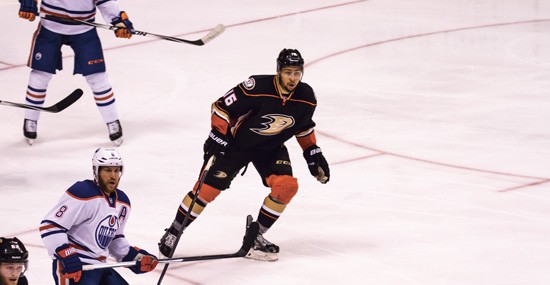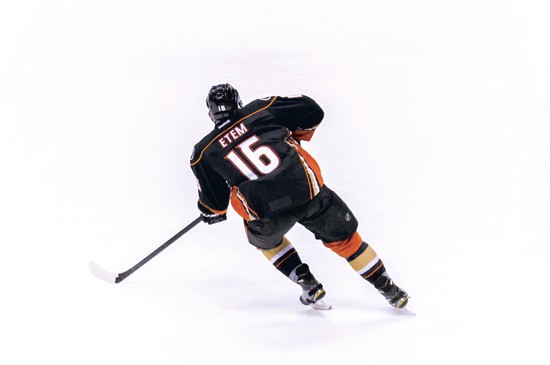
By Daniel Kohn
Any member of the Anaheim Ducks could've been easily forgiven if they had skipped the optional noontime practice at Anaheim ICE a couple of Saturdays ago. The team had just returned that morning, landing at John Wayne Airport at 2:15 a.m., following a 2-1 victory over the Minnesota Wild that ended a three-game losing streak. But, in a telling metaphor for the Ducks' season, which has had them leading the Pacific Division and in the running for the Presidents' Trophy as the top team in the NHL, most of the players showed up to the ice rink for practice without complaint–with joy, even, following the big win.
The players breezed through drills, brimming with confidence. They were crisp and spry, the atmosphere loose. Jokes flowed freely on the sidelines; on the ice, an unspoken urgency led everyone along, given their next game would be against potential playoff opponent Nashville Predators.
Near the end of the practice, the team went through 3-on-3 drills using only a fraction of the ice, designed to test reflexes and gumption. After a quick back-and-forth battle between the orange/black and white sides, the darker colors lead with seconds remaining. But Long Beach native Emerson Etem changed that. With a timely shot, right winger and former first-round draft pick for the Ducks tied up the mock game by weaving past a defender and firing a quick shot past goalie John Gibson.
“Emmer!” shouted his teammates, patting the 22-year-old on his helmet as he confidently skated past the goalie. Though the dark team ultimately won the scrimmage in overtime–with intersquad bragging rights for the day–everyone was in good spirits.
]
Practice ended with a brief speech by coach Bruce Boudreau, and most of the tired, jetlagged players headed back to the lockers. Etem, however, remained on the ice, even as a group of youth players took the other end of the rink. He spent nearly 15 minutes practicing his shooting. He needed it: The former first-round pick for the Ducks only had five goals at that point in the season. Etem fired shot after shot on the empty net until realizing he was the last Duck left.
Walking into the tunnel, Etem got congratulatory pats on the helmet by his teammates as they left for the day. He acknowledged them with a head nod before settling at his locker. “That was the biggest goal in the history of Ducks practice,” he said with a wry grin as he removed his pads. “We'll all look back and say, 'Wow, that was something!'”
Standing just taller than 6 feet, weighing 210 pounds and sporting a boyish goatee, Etem has the physique and the ideal combination of speed and agility that makes general managers dream of the next Alex Ovechkin, a prototype for the next generation of wingers. But there's something else about him that has the Ducks and the league excited, too.
Born in 1992, Etem is one of only six current NHL players who identify as African-American. But that's not all: He's one of the precious few professional hockey players to come from Southern California, as well as the first local prospect to play for an area team. In Etem's lifetime, the Ducks and Los Angeles Kings have gone from also-rans to model franchises that have won three of the past 10 Stanley Cups, yet they have little to show from homegrown talent despite millions of dollars spent on youth programs.
With Etem's trailblazing path, the NHL hopes to find more Southern Californian youth like him.
“Whether you're a Ducks fan, a Kings fan or even a Sharks fan, the more Stanley Cups we can get as a three-team thing in California will only grow the game,” Etem says. “With the Kings' past two Stanley Cups, it's definitely helped Southern California, and San Jose is always near the top as well. I think it first started out as a novelty–like, 'Let's just go see a couple of fights.' But now, people are seeing the speed of the game; they're really grabbing on to that.”
Adds Art Trottier, vice president of the Rinks, the Ducks' youth program, “In the next few years, you'll see more kids in the NHL from Southern California. The Emerson Etems of the world are great role models for these kids to look up to.”
[
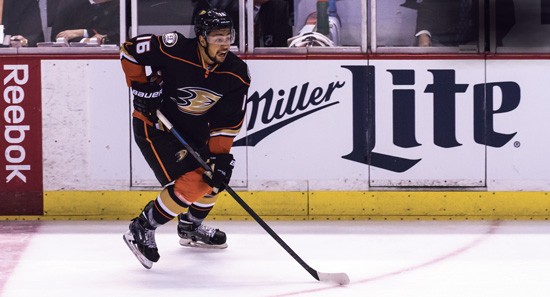
Etem's family has a rich sporting history. His mother, Patricia, participated in the 1984 Summer Olympics in Los Angeles as a rower (she made the 1980 team as well, but she did not participate in those games because of the U.S. boycott); his older brother, Martin, participated in the 2012 National Selection Regatta. It was Martin playing roller hockey a couple of blocks away from their home, at YMCA of Greater Long Beach in Bellflower, that sparked Etem's interest in the sport.
“[San Jose Sharks left wing] Matt Nieto was 3, and I was 3 and a half, and we were on the same [rollerblade hockey] team,” Etem recalls. “There's a good picture of us–him smiling with a missing tooth and me with a giant Afro. It's pretty hilarious. It's crazy [how] long ago that was, and now we're both here in the NHL.”
After three years of zipping around on rollerblades, Etem moved on to ice hockey. Playing at Lakewood Ice Rink (now run by the Ducks), he remembers being intimidated by the transition. But by Etem's second year, he started to hit his stride. Inspired by legendary right wing Pavel Bure's game–which relied on lightning speed and scoring prowess, instead of grit and burliness–Etem quickly became one of the Lakewood league's best players and moved up the ranks, hitting double digits in scoring before he hit that in age.
With his friends and father, Richard, Etem attended several Kings games each year. “It was one of those things where Long Beach is still LA County, even if I was closer to Honda Center than I was Staples,” Etem says, laughing. “All of my friends were Kings fans–whether they were from Valencia or Gardena, we rooted for them through those up-and-down years.”
He had an advantage other local youth didn't have: His parents were upper-middle class and more than happy to subsidize Etem's hockey ambitions. “Like any good parent would let their kid do whatever they wanted to do,” he recalls. “But they made sure I worked hard–obviously, hockey is an expensive sport, especially back in the day.”
But financial background or not, few parents were enrolling their children in hockey in Southern California during Etem's childhood. There weren't that many facilitites, and neither the Kings nor the Ducks were as involved in youth hockey back then, which severely hampered the ability of youths with an interest in the sport to pursue it. Nevertheless, Etem thrived, eventually earning a spot in famed local coach Sandy Gasseau's peewee AAA team.
“It's hard to tell at that age how far a player is going to go,” the coach says. “The first time I saw Emerson, he looked like a little pro player. He had a hard shot, fluid on the ice with his skating, a good-sized player.”
Though Etem and Nieto were a year younger than everyone else on the team, they were among the team's best players. Plus, current NHL players Pittsburgh Penguins right winger Beau Bennett and Minnesota Wild left winger Jason Zucker were also on the powerhouse squad.
“It was pretty incredible to have four NHL-ers on our team,” Etem says. “We pushed one another, and we got mad when one did better than the other–in a nice way. After practice or a game, we'd sleep over at one another's house. We were close, and we're still close today.”
His coach agrees. “They were all great athletes and very competitive,” Gasseau remembers. “They had all these intangibles and were passionate. They were skilled players and determined to get more skill and willing to work on their craft. My goal is when I have some players who are higher level than others, I had to focus on them as much as the players at a lesser level to make sure that they don't play down to a lower level than what they're capable of. I made sure they were challenged in a lot of ways to make sure they were complete players.”
By the time Etem turned 14, he was a bona fide prospect, but the teen faced a dilemma: He needed to leave Long Beach to pursue any NHL dreams. With the blessing of his parents, Etem moved to Faribault, Minnesota, to attend Shattuck-St. Mary's School, the famed hockey institution that his brother Martin attended. He made the prep team in only his second year, the same impressive leap taken by current NHL superstars Sidney Crosby, Jonathan Toews and Jack Johnson. Knowing the significance of playing on the prep team as a sophomore–and a Southern California native, to boot–pushed Etem even harder to take advantage of the opportunity. This time away from home trained him for both the rigors of hockey and the discipline he needed if he were to go professional.
“It was a great place for me to be entering my freshman year in high school,” he says. “I learned how to do laundry and to be a man at an early age.”
After a stint on the prep team, Etem headed to Ann Arbor, Michigan, to join the U.S. National Under-17 Team of USA Hockey's National Team Development Program. He was soon widely regarded as one of the best prospects in North America. Despite spending his teen years in the Midwest, though, Etem never lost his Southern California edge. He shared local bands such as Bad Religion–whom, he says, remain a favorite–and Sublime (“'The Ballad of Johnny Butt,' 'Badfish' and, obviously, 'Santeria' are my favorites”) with his teammates.
While in Michigan, Etem was drafted in the sixth round by the Medicine Hat Tigers of the Western Hockey League, one of the three leagues that comprise the Canadian Hockey League. Playing under future Vancouver Canucks head coach Willie Desjardins, his first season stats as a 17-year-old were great–37 goals and 28 assists–virtually guaranteeing his being drafted in the first round of the 2010 NHL Draft. Etem was rated the eighth best prospect by the NHL Central Scouting Bureau, which ranks players based on how well they'll perform at the pro level. With the draft taking place in Los Angeles, Etem was hoping to return home to his dream team.
On a June evening, Etem sat with his family and nearly 100 friends at Staples Center. Everyone expected his name to be called early on–even better if it were by the Kings, but the Ducks would do. The Ducks had the 12th pick and selected defenseman Cam Fowler. The Kings traded up to the 15th pick . . . but the team passed, going with Derek Forbort.
“Staples Center erupted [after the Kings traded up to 15], and I thought I was going to be picked by them,” he remembers.
As more names were called, including former teammate Bennett, Etem wondered where he'd end up and if he'd even be drafted in the first round, something that seemed a near-certainty earlier that evening. His group grew silent; returning home started to seem impossible. But using a pick acquired from the Philadelphia Flyers, the Ducks ended Etem's slide with the 29th.
“I wanted to be picked in the first round, so when the Ducks came around, I couldn't have been happier,” Etem says. “Right then and there, I felt home, and to be honest, I wouldn't have wanted it any other way.”
[
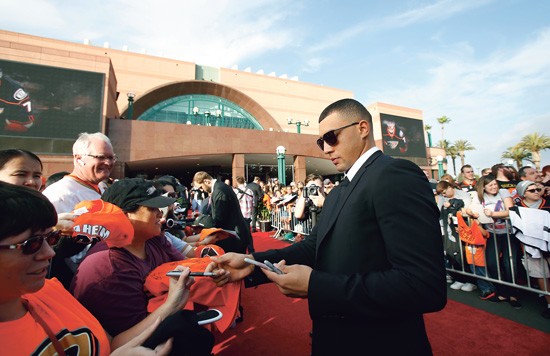
After removing his pads and skates and chatting with fellow winger Tim Jackman, Etem left the Anaheim ICE locker room and walked up the stands from the rink where the Ducks practice. Through a double door are the stands of an adjacent rink, where the crowd dwarfed the Ducks skatearound. Enthusiastic parents clap, whistle and cheer on their young kids.
Etem stopped to watch. “That was once me,” he says. “But hockey has grown so much since I started. It's cool to see.”
By the time Etem was readying to enter the pros, Southern California's youth ice hockey scene had grown dramatically, mostly thanks to the Ducks. In 2009, the team launched the Rinks development program, with one facility at Anaheim ICE and an inline one in Corona. The program has since grown to seven facilities (four ice rinks, three roller/inline) under the Ducks name.
The team's Learn to Play hockey program, which offers first-time hockey players between the ages of 4 and 10 the chance to learn the game, has been a success as well. Started in 2011 with 330 participants, it welcomed 3,340 first-time skaters this year (including an expansion into San Diego, where the team is moving its American Hockey League affiliate team from Norfolk next season).
But the Ducks haven't just fostered interest in youth leagues: An estimated 5,300 players are currently enrolled in adult leagues in Orange and Riverside counties and their surrounding areas (not including Los Angeles). And the Ducks-branded high school league has increased from one to 41 teams during the past six years.
Skating time at such Ducks-owned facilities in Anaheim, Westminster, Santa Ana and Long Beach has become harder to find, with more adult leagues locking in evening periods during the week. Many of the youth games happen on the weekend; judging by the heavily attended crowds, parents are just as excited to watch the games as their kids are to partake in the action.
Programs such as these and the ones Etem excelled in as a youth play an important part in the growth of hockey in Orange County. As football becomes more scrutinized because of its long-term health issues, hockey is steadily building a foundation for sustainable success in the area.
“Our ownership groups, which have local ties, are looking to grow the sport in Southern California,” says Trottier. “It's in everyone's best interest to try to grow the sport at an early level and to grow and create new hockey fans. Having people like Emerson Etem–with ties to Southern California–and the kids who are coming up in the AHL creates a lot of excitement for local hockey.”
Etem is the highest drafted Southern California-born and -trained player in Ducks history and the third-highest in NHL history (former teammate Bennett is currently the highest overall), showcasing the growth of the sport over the past two decades. And he thinks with the Ducks' current proto-farm system, more Southern California natives will get into the NHL.
“I wouldn't be shocked,” Etem says, “if one or two guys get drafted each year from Southern California.”
[
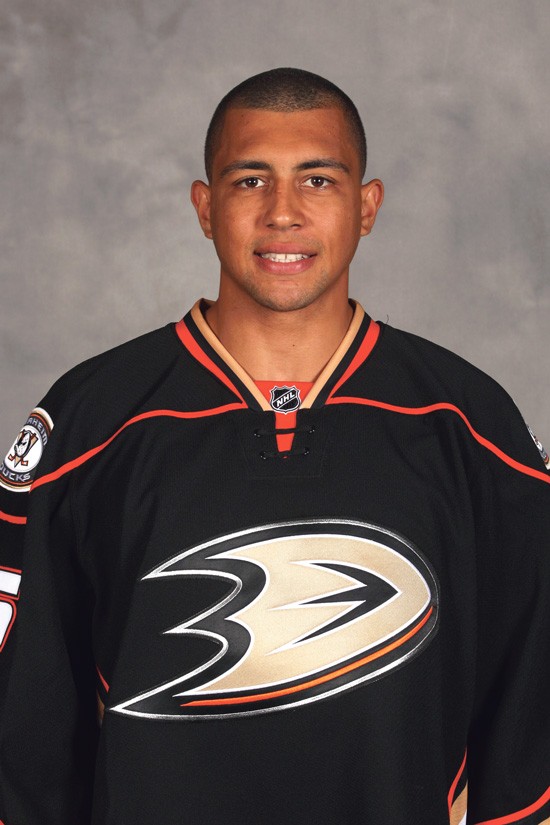
As with all first-round draftees, massive expectations followed Etem into the NHL. Ducks fans point to his dazzling performance as a rookie during the team's first-round series against Detroit in 2013–three goals and two assists in a losing effort–as proof of his potential. Reality, though, has been a bit tougher, as Etem has yo-yoed between the Ducks and the Norfolk Admirals, the Ducks' AHL team.
“It's frustrating, but everyone has been through it,” he says. “Some longer than others, but at the same time, 80 percent of the league goes through it. At the end of the day, it's hockey, and you're going down there and working on your skill, and as long as [management] know you're working on the things they want you to work on, you'll be back up here.”
His time with the Ducks almost came to an abrupt end when he was nearly traded to Vancouver for Ryan Kesler (who eventually ended up in Anaheim) in January 2014, only to have the trade nixed when the Canucks' owner refused to sign off on it. And since the Saturday optional practice, Etem has been shuffled in and out of the lineup as a healthy scratch.
That doesn't mean the team doesn't have big hopes for Etem. His locker in the Honda Center is in the same row as captain Ryan Getzlaf and leading scorer Corey Perry. “He's big, he's strong, and he brings a lot when he skates,” says Boudreau. “He's got a nose for the net and knows what he has to do to be more consistent. He has all the ability in the world to be a good NHL player.”
With the playoffs beginning next week, Etem's play will be a key in determining whether the team can match its regular season success and capture the second Stanley Cup in team history. More important, if the Long Beach native can relive his past playoff success, Etem's status as a local hero to thousands of hockey-playing youths in the greater Orange County and Long Beach area will be cemented–because if he can do it, anyone can.
“I like to think of myself as a fun, outgoing guy,” he says. “I do stuff any normal 22-year-old does. I like to have fun, and I like to surf. But I take things one day at a time and keep working hard at what I do.”
